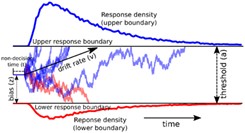Drift diffusion modelling: Probing without peeking?
Many of the central questions of human systems neuroscience boil down to 'which brain regions do what' and 'how do they do it'. The obvious way to tackle is to lift up the skull and go exploring with electrodes, not dissimilar to how a cave explorer might want to map out a system of cave halls and corridors. This is, however, not only impractical but not something any one of us would be happy to subject ourselves to. As such, we need to find workarounds and look for tracks and prints the brain leaves behind when it's busy at work, just like the explorer above would look for natural springs and nesting habits of bats. An elegant solution to this is drift diffusion modelling, DDM for short.
Using this powerful technique, we gather only behavioral data for a human participant, such as reaction time and accuracy, in a completely painless and non-invasive manner, and then reconstruct the individual processes which would necessarily had to have taken place to produce this data . For example, so-called non-decision time is the minimum amount of time someone needs to give an answer in a cognitive task, such as ' what color is the image, red or green? 'regardless of whether or not they get it right. At its most basic, this most likely reflects a process of basic sensory-motor integration and movement execution.
The basic premise of DDM is that subjects, humans in this case, continuously sample their environment for clues when trying to make a decision. The evidence is only probabilistic. The evidence for one or the other decision accumulates over time until it reaches a putative threshold of one option, after which the subject indicates this response. Alas, the environment and the brain processes are noisy and so the evidence is probabilistic. 

By constructing models of decision making using DDM, we can then cross-reference these with existing frameworks and invasive data, such as electrode recordings from monkeys. This provides us with powerful tools to explore brain functionality – without any of the hassle that is caving.
Such approach has already been implemented in some of our studies, including Large et al., 2019 whereby we showed how the development of autistic children differs from that of non-autistic children in terms of the DDM parameters. This research is currently being conducted by Revan Rangotis in the lab.
Large I, Pellicano E, Mojzisch A, Krug K. Developmental trajectory of social influence integration into perceptual decisions in children. Proc Natl Acad Sci US A. 2019 Jan 28;116(7):2713-2722.